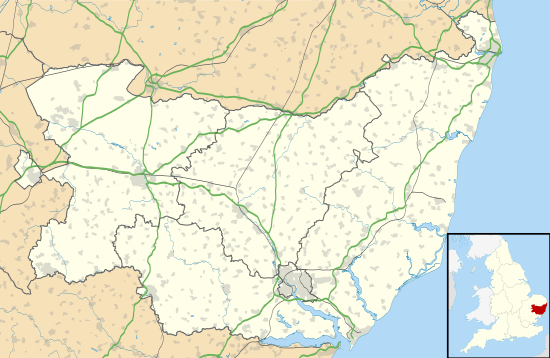Semer, Suffolk
Semer is a small village and civil parish in Suffolk, England.[2] Located adjacent to a bridge over the River Brett on the B1115 between Hadleigh and Stowmarket, it is part of Babergh district. The parish also contains the hamlets of Ash Street and Drakestone Green.
| Semer | |
|---|---|
 All Saints Church | |
 Semer Location within Suffolk | |
| Population | 130 (population of the whole parish in 2011)[1] |
| District | |
| Shire county | |
| Region | |
| Country | England |
| Sovereign state | United Kingdom |
| Post town | Ipswich |
| Postcode district | IP7 |
| UK Parliament | |

The parish was recorded in the 2011 census as having a population of 130, down from 158 in the previous census.[1]
History
Semer is recorded in the Domesday Book as belonging to Bury St Edmunds Abbey in both 1066 and 1086.[3] The abbey acted as both Lord of the Manor and Tenant-In-Chief.[3]
The village is recorded as home to 20 households: six villagers, 13 small holders and one slave.[3] It is recorded as having enough ploughland for 3 lord's plough teams and 3 men's plough teems; and the village also had 12 acres of meadow, a mill, a church, 0.25 acres of church land, 16 cattle, 2 cobs, 24 pigs and 97 sheep.[3]
In 1086 the village is valued as worth £6 a year to its lord, Bury St Edmunds Abbey, a £1 increase on its value in 1066.[3] Its taxable value is recorded as 3.8 geld units and 2.5 villtax.[3]
All Saints Church
The small church is set a few hundred yards off of a minor road across a meadow beside the River Brett, It is almost entirely Victorianised with a chancel that was rebuilt in 1870. One notable feature of the graveyard, to the east of the church, is a marble Edwardian angel scattering roses.[4]
The church has a plain square-cut font which is though to be 14th-century, as is the nave. There is also a Royal Arms of King George III, painted before the union with Ireland.[5]
The church has three bells. The bell nearest to Church Lane is dated 1621 but is unused; the other two working bells, nearest to the East end, are used weekly; the middle one dated 1618 and cast at Bury. The bells seem to originally have swung, but the clappers are now tied to the rope and swing against the interior of the bell. The inscriptions on the bells are:
- 1st Bell Johannes me fecit, T.G. 1618 ("John made me")
- 2nd Bell Meritis Edmundi scimus a crimine mundi ("Through the merits of Edmund may we be clean from guilt")
- 3rd Bell Thomas Cheese me fecit, 1621 ("Thomas Cheese made me") [6]
Hamlets
Ash Street
The small hamlet of Ash Street is centred approximately 0.5 miles (1 km) east of Semer church; it is located to the north of a bridge over the River Brett.
Ash Street is recorded in the Domesday Book as a very small settlement of just five smallholders, with 6 acres (2.4 ha) of meadow and a mill; the hamlet had a taxable value of 1.5 geld units.[7] Prior to the Norman Conquest of 1066, the hamlet was owned by an unnamed "Free Woman".[7] After the Conquest it is recorded as under the Lordship of William the Conqueror's half-brother: Robert, Count of Mortain.[7]
Drakestone Green
The small hamlet of Drakestone Green is centred approximately 1 mile (1.6 km) south of Semer church.
References
- "Semer: Key Statistics". 2011 Census. Retrieved 25 April 2013.
- Kelly, E. R., ed. (1875). "SEMER". The Post Office Directory of Cambridge, Norfolk and Suffolk. London: Kelly & Co. p. 907.
- "Semer". Domesday Map. Retrieved 29 April 2013.
- "Suffolk Churches". www.suffolkchurches.co.uk.
- "About us - Semer, All Saints - A Church Near You". www.achurchnearyou.com.
- "Church Bells » Semer". semer.onesuffolk.net.
- "Ash Street". Domesday Map. Retrieved 25 April 2013.
External links


- Ash [Street] in the Domesday Book